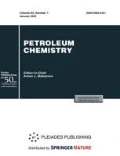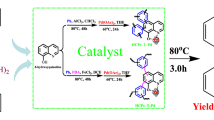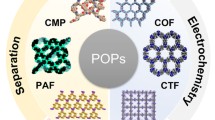Abstract
A novel method for incorporation of palladium nanoparticles into a porous hypercrosslinked polystyrene matrix has been developed. The composite obtained by reduction of [Pd(π-allyl)Cl]2 with hydrogen in supercritical CO2 shows high catalytic activity in the hydrogenation of benzene and can be used twelve (12) times in a row without any decrease in conversion rate. The catalyst is also suitable for quantitative hydrogenation of toluene, tetralin and phenol. The obtained catalytic system is compared with the palladium composite synthesized by a conventional method based on hypercrosslinked polystyrene.
Similar content being viewed by others
Cyclohexane and its derivatives are important chemical products widely used in organic synthesis (solvents), petroleum chemistry, and pharmaceutical production [1–3]. Cyclohexane derivatives can be obtained either by cyclohexane modification or by hydrogenation of respective substituted aromatic compounds. Due to the low reactivity of cyclohexane, its modification methods are of low efficiency and therefore used comparatively rarely. Thus, catalytic hydrogenation of aromatic derivatives is the main way to obtain substituted derivatives of cyclohexane. Also, of great interest is phenol hydrogenation for obtaining cyclohexanone, which is the basic raw material for the synthesis of adipic acid and caprolactam [4].
Many various metal-complex systems are used as catalysts for benzene-to-cyclohexane hydrogenation; however, the homogeneous catalytic processes, even though they are usually highly active, have some serious drawbacks, the major ones being complexity of separation of the catalyst from reaction products and that it cannot be recycled [5, 6]. As regards the well-known heterogeneous benzene-to-cyclohexane hydrogenation catalysts, they are represented by the systems based on nickel, platinum, palladium, rhodium, iridium, and ruthenium [7].
In order to increase catalytic activity of heterogeneous catalysts, activity that depends on the size of the metal surface area available for the reacting molecules, it is conventional to use catalysts applied to the porous surface of carriers of an inorganic or polymeric nature. Hypercrosslinked polystyrene (HCP) is one of the promising polymeric supports that is notable for its very high specific surface area (normally ranging from 800 to 1500 m2/g) [8]. For example, nanoparticles of Pt, Pd and Ru incorporated into the HCP matrix have been used for selective oxidation of lactose, glucose, and sorbose [9–12]. Pt and Ru nanoparticles applied to the MN-270 commercial microporous HCP copolymer have been efficiently used for oxidation of phenol dissolved in water [13–14]. Pd nanoparticles immobilized into the MN-270 styrene-divinyl-benzene polymer have been studied in the course of hydrogenation of stearic acid to heptadecane [15]. The catalyst in question has also been tested successfully in the course of phenol gas phase hydrogenation [7]. HCP containing Pd nanoparticles demonstrated high activity in a reaction wherein aryl bromides and chlorides were coupled with phenyl boronic acid [17]. The MN-100 crosslinked copolymer containing Rh nanoparticles demonstrated high activity in the course of olefin hydroformylation in supercritical CO2 during six catalytic cycles without any loss of conversion rate [18].
In this paper a novel method for obtaining Pd nanoparticles in the HCP matrix is described; the method represents decomposition-reduction of [Pd(π-allyl)Cl]2 in supercritical CO2/H2, after which the obtained composite is used in hydrogenation of benzene, toluene, tetralin, and phenol.
EXPERIMENTAL
Bi-porous hypercrosslinked styrene-divinyl-benzene polymer Macronet MN-200 with the pore sizes being 71 and 1.6 nm and specific surface area 1100 m2/g (Purolite, Great Britain) was used as an adsorbent; it was washed with МеОН and dried at 110°C for 30 min before use. Bis-π-allyl palladium chloride (from Sigma-Aldrich) and palladium chloride (from Aurat JSC) were used without any additional treatment.
[Pd(π-allyl)Cl]2, 101 mg, were dissolved in CH2Cl2 (2.4 mL) and then added to hypercrosslinked polystyrene (0.7 g); the solvent was removed in vacuum. The reduction of the applied complex to metal was carried out in a stainless steel autoclave, in hydrogen atmosphere (55 atm), and then CO2 was added to increase the total pressure up to 150 atm. The mixture was heated for 3 h (50°С), whereafter the pressure was slowly decreased. The obtained grey composite was washed with acetone (5 mL) and dried in vacuum.
For comparison a palladium catalyst was prepared by a conventional method, wherein 150 mg of PdCl2 were simultaneously being heated and dissolved in 1 mL of H2O and 0.1 mL of concentrated HCl, and added to 1.0 g of the Macronet MN-200 adsorbent. The polymer expanded in the above solution for 20 min, and then a solution containing 600 mg of sodium formate and 450 mg of NaOH in 2 mL of H2O was added thereto. The obtained mixture was heated for 10 min at 80°С; the resulting composite product was washed with water (30 mL) and МеОН (10 mL) and then heat-dried in vacuum (90°С).
The palladium content in the samples was determined by X-ray fluorescence analysis using an Innov-X α-2000 X-ray spectrometer. The morphology of the samples was examined with a Hitachi HT7700 transmission electron microscope. X-ray powder patterns were obtained with a Bruker D8 Advanced diffractometer using CuKα (λ = 1.5406 Å) radiation.
Hydrogenation of aromatic compounds was carried out for 24 h in a stainless steel autoclave at temperatures ranging from 55 to 110°С, under the required hydrogen pressure, in a substrate medium, which was methylene chloride, or in supercritical CO2. When the reaction was completed, the liquid reaction mixture was separated from the solid catalyst and analyzed by methods such as GLC (Crystall-2000M) and 1H NMR (Bruker 400). Prior to being recycled, the catalyst was dried in vacuum and washed with CH2Cl2.
RESULTS AND DISCUSSION
According to the X-ray fluorescence analysis data, the average palladium content in the composites obtained by reduction in supercritical CO2 (sample 1) or with sodium formate in an aqueous medium (see above) (sample 2) was 6.0 and 6.07 wt %, respectively. Figure 1 shows the X-ray powder patterns of both composite samples: on sample 1 (Fig. 1a) we can clearly see the 2θ diffraction peaks at 39.98° and 46.56°, and on sample 2 (Fig. 1b), only at 39.98°; the peaks correspond to the face-centered cubic crystalline structure of Pd nanoparticles. The crystallite size calculation based on the integral breadth of reflections with the use of the Lvol IB formalism shows that the average size of Pd nanoparticles is 14.0 and 8.3 nm for samples 1 and 2, respectively.
Also, the size and morphology of Pd(0) nanoparticles in the polymer were examined by analyzing the fine composite material with the help of a transmission electron microscope (TEM) (Fig. 2).
Nanoparticles of 5 to 8 nm were found to have been formed in sample 1 along with large palladium clusters. Sample 2 contains palladium particles of virtually the same size (~10 nm), but these are less densely distributed in the HCP matrix. The histograms showing the distribution of particles in the samples obtained in supercritical CO2 and in water are in Fig. 3.
Palladium composites were used as catalysts for hydrogenation of model aromatic hydrocarbons (Table 1).
As follows from the data above, benzene conversion at 55°C was 55%, and the increase in the reaction temperature to 110°С resulted in full conversion of the substrate. As regards the palladium catalyst obtained in aqueous medium, benzene conversion in that case was only 64% under the same conditions (110°С).
A series of 12 successive hydrogenation cycles was carried out to check whether the catalyst could be recycled. Full benzene conversion was achieved under the same conditions in all the tests, and after completion of the last cycle no traces of benzene in the reaction mixture were found.
It is also worth noting that during the successive tests, according to the X-ray fluorescence data, palladium particles are not “washed out” of the carrier matrix. Besides benzene, toluene and tetralin were hydrogenated on a catalyst regenerated in the supercritical CO2 medium. They were quantitatively hydrogenated to methylcyclohexane and decalin, respectively (Table 1).
The catalyst was also used for phenol hydrogenation in CH2Cl2 without solvents, and in supercritical СО2 (Table 2).

In the CH2Cl2 case, virtually full conversion of phenol is observed, with the cyclohexanol/cyclohexanone ratio being 19/81 (Table 2, test 1); as we can see, selectivity remains nearly the same at a higher hydrogen pressure (Table 2, test 2). Without a solvent, virtually full substrate conversion is achieved as well, but selectivity is lower (Table 2, test 3). When supercritical CO2 is used as the reaction medium, cyclohexanol becomes the main product (Table 2, test 4), and its yield is slightly lower at a higher temperature (Table 2, test 5).
In summary, this paper introduces a novel method of formation of palladium nanoparticles by reduction of [Pd(π-allyl)Cl]2 with hydrogen in supercritical СО2 in a hypercrosslinked polystyrene matrix. The obtained composite demonstrated high activity during benzene hydrogenation, which did not decline when one and the same catalyst sample was used 12 times. Furthemore, the catalyst proved to be efficient during hydrogenation of toluene to methylcyclohexane and tetralin to decalin, as well as during hydrogenation of phenol to cyclohexanol and cyclohexanone in the CH2Cl2 medium, in supercritical CO2, and in the substrate.
ADDITIONAL INFORMATION
S.E. Lyubimov, ORCID: http://orcid.org/0000-0002-7076-7325
A.A. Zvinchuk, ORCID: http://orcid.org/0000-0001-8257-729X
A.A. Korlyukov, ORCID: http://orcid.org/0000-0002-5600-9886
V.A. Davankov, ORCID: http://orcid.org/0000-0002-1018-1840
O.P. Parenago, ORCID: http://orcid.org/0000-0002-4869-4035
REFERENCES
Stanislaus, A.B. and Cooper, H., Catal. Rev., 1994, vol. 36, p. 75. https://doi.org/10.1080/01614949408013921
Maegawa, T., Akashi, A., Yaguchi, K., Iwasaki, Y., Shigetsura, M., Monguchi, Y., and Sajiki, H., Chem. Eur. J., 2009, vol. 15, p. 6953. https://doi.org/10.1002/chem.200900361
Domanska, U., Morawski, P., and Piekarska, M., J. Chem. Thermodynamics., 2008, vol. 40, p. 710. https://doi.org/10.1016/j.jct.2007.10.004
Nelson, N., Manzano, J., Sadow, A., Overbury, S., and Slowing, I., ACS Catal., 2015, vol. 5, p. 2051. https://doi.org/10.1021/cs502000j
Rakowski, M.C., Hirsekorn, F.J., Stuhl, L.S., and Muetterties, E.L., Inorg. Chem., 1976, vol. 15, no. 10, p. 2379. https://doi.org/10.1021/ic50164a013
Bayram, E., Linehan, J.C., Fulton, J.L., Roberts, J.A.S., Szymczak, N.K., Smurthwaite, T.D., Ozkar, S., Balasubramanian, M., and Finke, R.G., J. Am. Chem. Soc., 2011, vol. 133, p. 18889. https://doi.org/10.1021/ja2073438
Zhu, L., Sun, H., Fu, H., Zheng, J., Zhang, N., Li, Y., and Chen, B.H., Appl. Catal. A: Gen., 2015, vol. 49, p. 124. https://doi.org/10.1016/j.apcata.2015.04.016
Tan, L. and Tan, B., Chem. Soc. Rev., 2017, vol. 46, p. 3322. https://doi.org/10.1039/c6cs00851h
Sidorov, S.N., Volkov, I.V., Davankov, V.A., Tsyurupa, M.P., Valetsky, P.M., Bronstein R. Karlinsey, L.M., Zwanziger, J.W., Matveeva, V.G., Sulman, E.M., Lakina, N.V., Wilder, E.A., and Spontak, R.J., J. Am. Chem. Soc., 2001, vol. 123, no. 43, p. 10502. https://doi.org/10.1021/ja0107834
Sulman, E., Matveeva, V., Bronstein, L., Sidorov, A., Lakina, N., Sidorov, S., and Valetsky, P., Green. Chem., 2003, vol. 5, p. 2005. https://doi.org/10.1039/B210350H
Sulman, E., Doluda, V., Dzwigaj, S., Marceau, E., Kustov, L., Tkachenko, O., Bykov, A., Matveeva, V., Sulman, M., and Lakina, N., J. Mol. Catal. A: Chem., 2007, vol. 278, p. 112. https://doi.org/10.1016/j.molcata.2007.08.029
Sulman, E.M., Matveeva, V.G., Bronstein, L.M., Sulman, M.G., Doluda, V.D., Tokarev, A.V., Murzina, E.V., and Murzin, D.Yu., Stud. Surf. Sci. Catal., 2006, vol. 162, p. 119. https://doi.org/10.1016/S0167-2991(06)80898-0
Doluda, V.Yu., Sulman, E.M., Matveeva, V.G., Sulman, M.G., Lakina, N.V., Sidorov, A.I., Valetsky, P.M., and Bronstein, L.M., Chem. Eng. J., 2007, vol. 134, p. 256. https://doi.org/10.1016/j.cej.2007.03.069
Doluda, V.Yu., Sulman, E.M., Matveeva, V.G., Sulman, M.G., Bykov, A.V., Lakina, N.V., Sidorov, A.I., Valetsky, P.M., and Bronstein, L.M., Top. Catal., 2013, vol. 56, p. 688. https://doi.org/10.1007/s11244-013-0028-z
Sapunov, V.N., Stepacheva, A.A., Sulman, E.M., Warna, J., Maki-Arvela, P., Sulman, M.G., Sidorov, A.I., Stein, B.D., Murzin, D.Yu., and Matveeva, V.G., J. Ind. Eng. Chem., 2017, vol. 46, p. 426. https://doi.org/10.1016/j.jiec.2016.11.013
Sulman, E.M., Ivanov, A.A., Chernyavsky, V.S., Sulman, M.G., Bykova, A.I., Sidorov, A.I., Doluda, V.Yu., Matveeva, V.G., Bronstein, L.M., Stein, B.D., and Kharitonov, A.S., Chem. Eng. J., 2011, vols. 176–177, p. 33. https://doi.org/10.1016/j.cej.2011.05.044
Lyubimov, S.E., Vasil’ev, A.A., Korlyukov, A.A., Ilyin, M.M., Pisarev, S.A., Matveev, A.E., Chalykh, V.V., Zlotin, S.G., and Davankov, V.A., React. Funct. Polym., 2009, vol. 69, p. 755. https://doi.org/10.1016/j.reactfunctpolym.2009.06.004
Lyubimov, S.E., Rastorguev, E.A., Lubentsova, K.I., Korlyukov, A.A., and Davankov, V.A., Tetrahedron Lett., 2013, vol. 54, p. 1116. https://doi.org/10.1016/j.tetlet.2012.12.063
Talukdar, A.K., Bhattacharyya, K.G., and Sivasanker, S., Appl. Catal. A: Gen., 1993, vol. 96, p. 229. https://doi.org/10.1016/0926-860X(90)80012-4
Chen, H., He, Y., Pfefferle, L.D., Pu, W., Wu, Y., and Qi, S., Chem. Cat. Chem., 2018, vol. 10, p. 2558. https://doi.org/10.1002/cctc.201800211
Chatterjee, M., Kawanami, H., Sato, A., Chatterjee, T., and Yokoyama, T., Adv. Synth. Catal., 2009, vol. 351, p. 1912. https://doi.org/10.1002/adsc.200900144
Rode, C.V., Joshi, U.D., Sato, O., and Shirai, M., Chem. Commun., 2003, p. 1960. https://doi.org/10.1039/B304344D
Funding
This work was funded by the Russian Foundation for Basic Research (grant no. 18-29-06032). The authors are grateful to the Department of Structural Studies at N.D. Zelinsky Institute of Organic Chemistry (Moscow) for the electron microscopy analysis.
Author information
Authors and Affiliations
Corresponding author
Ethics declarations
No conflict of interest was declared by the authors.
Rights and permissions
Open Access. This article is distributed under the terms of the Creative Commons Attribution 4.0 International License (http://creativecommons.org/licenses/by/4.0/), which permits unrestricted use, distribution, and reproduction in any medium, provided you give appropriate credit to the original author(s) and the source, provide a link to the Creative Commons license, and indicate if changes were made.
About this article
Cite this article
Lyubimov, S.E., Zvinchuk, A.A., Korlyukov, A.A. et al. Palladium Nanoparticles in Hypercrosslinked Polystyrene: Synthesis and Application in the Hydrogenation of Arenes. Pet. Chem. 61, 76–80 (2021). https://doi.org/10.1134/S0965544121010084
Received:
Revised:
Accepted:
Published:
Issue Date:
DOI: https://doi.org/10.1134/S0965544121010084







